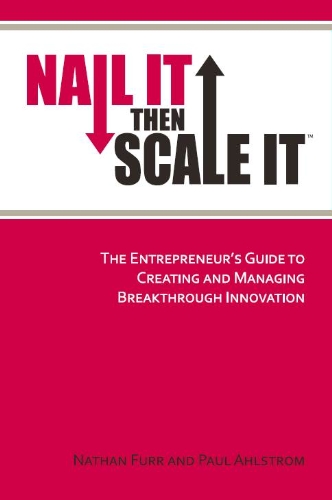Physical Address
304 North Cardinal St.
Dorchester Center, MA 02124

“Successful startups are the ones who have enough money
left over to try their second idea.”
—Clayton Christensen, Author and Harvard Professor
 One of the best books we’ve come across on starting a business is Nail It Then Scale It by Nathan Furr and Paul Ahlstrom. Whether you’re just getting started, or struggling to ramp up your business, this book is a must-read.
One of the best books we’ve come across on starting a business is Nail It Then Scale It by Nathan Furr and Paul Ahlstrom. Whether you’re just getting started, or struggling to ramp up your business, this book is a must-read.
The key idea of the book is that you need to “nail” the business model and prove that it will work, before you sink money into “scaling” the business to a wider audience.
Sounds a lot like one of the ideas outlined by Jim Collins in his book, Great by Choice. Mr. Collins advises, first fire off a few bullets, then, once you’ve found your target, shoot your cannonballs.
Trouble is, many small businesses do this wrong. They have a great idea and just know it will be a success. So they start building the solution, spending weeks or even months honing their product to solve the problem.
Then comes launch day and… crickets.
They don’t understand why customers aren’t streaming in the door. After all, they’ve solved a problem with a great solution.
From the book, NITSI:
…the three mistakes we see entrepreneurs make are 1) guessing but not testing the pain, 2) selecting a small customer pain (low on the pain scale), or 3) selecting a narrow customer pain (small numbers of customers willing to pay); and as a result, either customers aren’t willing to pay or the business isn’t worth the entrepreneur’s time to build.
So how do you as a small business owner solve these problems?
Fire a few bullets before you fire off your cannons.
Bullets are low-cost, low-risk, and low distraction tests or experiments. They are used to validate that the problem you are solving is one that needs to be solved. Or that your solution fixes the problem in a way that customers are willing to pay. Or that enough customers have the problem to make this an attractive market to pursue.
Once you know that these small bullets hit the mark, you ramp up and fire off the cannons. Small businesses should be in the business of firing lots of bullets. Why? Because unlike big businesses, that may be able to afford wasting money on big bets, you have less time and money to see those bets pay off.
You need to succeed before you run out of money.
So by testing lots of small ideas cheaply and quickly, you can discover what works and what doesn’t before you make a big bet that may not work out.
Let’s say you want to know if there’s a market for your idea—a print-at-home newspaper that combines news from several different sources around the world. This is a pretty bad idea, but it makes a good example.
First, put up a website that describes the problem and solution. Add a simple form that collects emails and tells potential customers that you will notify them as soon as you launch.
Second, put together a small Pay Per Click (PPC) Campaign in Google Adwords. Choose a few key words that will attract your ideal customer. In this case maybe “personalized newspaper”, “do-it-yourself news”, or “print-at-home news”. Budget a small amount (say $500) and let the campaign run.
Third, analyze the results. Did anyone respond? What was the cost to acquire each potential customer? If 10% of them were to sign up, how much could you make? Now do the math: how much would you have to spend in Adwords to acquire each customer? Will the customer spend that much with you over the next year? Calculate your potential profit (or loss).
You can do similar things for other business ideas. Do you have an awesome salsa recipe and want to know if you can build a business around it? Make a batch, package it, and take it to the farmer’s market, or to work, or anywhere. Will people pay for it? Will they buy it more than once? How much? Can you make enough to justify your time? Can you easily get it in their hands when they are ready to purchase?
First nail the model, then scale your business. Or fire a few bullets, then open up with the cannons.
A lot of bullets will miss. That’s okay. In fact, that’s why you fire the bullets in the first place, to learn what hits and what misses. Firing bullets allows you to make adjustments in your target, your strategy, your product features—everything as you hone in on what works at a cost that won’t sink your business.
Once a bullet hits a target (and you confirm that it isn’t a fluke), then it’s time to ramp up and fire a cannonball. Now that you know you can hit your target, or solve the problem, pour your resources into scaling the solution to reach as many customers as possible, as quickly as possible.
Want to learn more? Read the books:
Nail It Then Scale It by Nathan Furr and Paul Ahlstrom
Great by Choice by Jim Collins and Morton Hansen